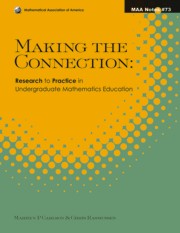Book contents
- Frontmatter
- Preface
- Contents
- Part 1 Student Thinking
- Part 2 Cross-Cutting Themes
- 2a Interacting with Students
- 13 Meeting New Teaching Challenges: Teaching Strategies that Mediate Between All Lecture and All Student Discovery
- 14 Examining Interaction Patterns in College-Level Mathematics Classes: A Case Study
- 15 Mathematics as a Constructive Activity: Exploiting Dimensions of Possible Variation
- 16 Supporting High Achievement in Introductory Mathematics Courses: What We Have Learned from 30 Years of the Emerging Scholars Program
- 2b Using Definitions, Examples and Technology
- 17 The Role of Mathematical Definitions in Mathematics and in Undergraduate Mathematics Courses
- 18 Computer-Based Technologies and Plausible Reasoning
- 19 Worked Examples and Concept Example Usage in Understanding Mathematical Concepts and Proofs
- 2c Knowledge, Assumptions, and Problem Solving Behaviors for Teaching
- 20 From Concept Images to Pedagogic Structure for a Mathematical Topic
- 21 Promoting Effective Mathematical Practices in Students: Insights from Problem Solving Research
- 22 When Students Don't Apply the Knowledge You Think They Have, Rethink Your Assumptions about Transfer
- 23 How Do Mathematicians Learn To Teach? Implications from Research on Teachers and Teaching for Graduate Student Professional Development
- About the Editors
22 - When Students Don't Apply the Knowledge You Think They Have, Rethink Your Assumptions about Transfer
from Part 2 - Cross-Cutting Themes
- Frontmatter
- Preface
- Contents
- Part 1 Student Thinking
- Part 2 Cross-Cutting Themes
- 2a Interacting with Students
- 13 Meeting New Teaching Challenges: Teaching Strategies that Mediate Between All Lecture and All Student Discovery
- 14 Examining Interaction Patterns in College-Level Mathematics Classes: A Case Study
- 15 Mathematics as a Constructive Activity: Exploiting Dimensions of Possible Variation
- 16 Supporting High Achievement in Introductory Mathematics Courses: What We Have Learned from 30 Years of the Emerging Scholars Program
- 2b Using Definitions, Examples and Technology
- 17 The Role of Mathematical Definitions in Mathematics and in Undergraduate Mathematics Courses
- 18 Computer-Based Technologies and Plausible Reasoning
- 19 Worked Examples and Concept Example Usage in Understanding Mathematical Concepts and Proofs
- 2c Knowledge, Assumptions, and Problem Solving Behaviors for Teaching
- 20 From Concept Images to Pedagogic Structure for a Mathematical Topic
- 21 Promoting Effective Mathematical Practices in Students: Insights from Problem Solving Research
- 22 When Students Don't Apply the Knowledge You Think They Have, Rethink Your Assumptions about Transfer
- 23 How Do Mathematicians Learn To Teach? Implications from Research on Teachers and Teaching for Graduate Student Professional Development
- About the Editors
Summary
Teaching so that knowledge generalizes beyond initial learning experiences is a central goal of education. Yet teachers frequently bemoan the inability of students to use their mathematical knowledge to solve real world applications or to successfully tackle novel extension problems. Furthermore, researchers have been more successful in showing how people fail to transfer learning (i.e., apply knowledge learned in one setting to a new situation) than they have been in producing it (McKeough, Lupart, & Marini, 1995). Because we are most frequently prompted to reflect upon transfer when it doesn't occur, this chapter begins with an undergraduate teaching vignette in which the students did not appear to apply the knowledge that the teacher thought they had developed.
If we presented a vignette of mathematics instruction dominated by the presentation of decontextualized formulas, it would come as little surprise if students struggled to solve real world applications. Instead, the vignette is drawn from a specially designed two-semester course in calculus for biology majors, with several features considered to promote the transfer of learning. First, major concepts were developed using biological contexts, followed by homework problems and on-line worked examples drawn from multiple contexts. Second, explicit connections were drawn between real world situations and abstract representations such as formulas and graphs. Finally, the course materials emphasized conceptual development, not just procedural competency. Specifically, many applets were created to help students develop underlying concepts and to explore dynamic mathematical models.
- Type
- Chapter
- Information
- Making the ConnectionResearch and Teaching in Undergraduate Mathematics Education, pp. 289 - 304Publisher: Mathematical Association of AmericaPrint publication year: 2008
- 22
- Cited by

